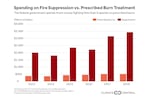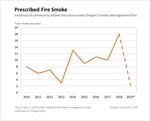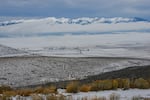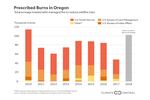Three years ago Willy Crippen had his sights set on lighting a fire in the foothills of the Elkhorn Mountains, the picture-postcard backdrop for the northeast Oregon town of Baker City.

Smoke covers a hillside in the Applegate Valley of southwestern Oregon during a prescribed burn operation.
Jes Burns / OPB
The fire management officer for the Wallowa-Whitman National Forest knew this was an important spot to use prescribed fire. It was close to town in the watershed that serves Baker City’s municipal water supply. This type of low-intensity fire can help reduce wildfire risk by cleaning out small trees, dead branches and leaves, as well as any piles of limbs and trees left behind after forest thinning and logging efforts.
But Crippen also knew it would be a tough place to burn.
“The town being right at the base of the mountain range, smoke goes downhill at the end of the day, and smoke comes right directly into town,” Crippen said.
Like all fire, prescribed burns produce smoke. In 2016, Oregon rules did not allow any visible, ground-level smoke to come into town.
Crippen and his team's goal was to burn 400 acres in the watershed above Baker City.
“We got 45 acres done before we had to shut down because of smoke conditions,” he said.
A Smoky Problem
Pollution from burning fossil fuels like coal and natural gas is trapping heat, making summers hotter and drier and lengthening wildfire seasons.
Prescribed fire is widely seen as one of the best tools we have to restore forests and manage the risk of severe wildfire. But there’s a broad acknowledgment that we’re not getting nearly enough fire on the ground to achieve those goals.
Federal funding for prescribed burning remained stagnant over the past five years as spending on wildfire suppression continued to rise at an alarming rate.

Spending on fire suppression vs. prescribed burn treatments nationwide
Climate Central
Across the Western United States, funding and capacity issues are the primary barriers to getting more prescribed fire on the ground according to a 2018 paper out of the University of Oregon and Colorado State University. The one exception to this was the Pacific Northwest.
Related: How Land Managers Select Prescribed Fire Areas
“In Oregon and Washington, one of the things that we found in the interviews is that burners — essentially the land managers and others that are implementing burning — said that air quality regulation is a major barrier to the burning that they're doing,” said researcher Heidi Huber-Stearns, director of the University of Oregon Ecosystem Workforce Program.
The state of Oregon regulates that smoke in much of the state – including on federal land. The regulations are there to protect population centers, places that have had air quality issues in the past, and viewsheds in natural protected areas.
But it appears this barrier is starting to crumble.
“We had smoke impacts in our communities from wildfires that, by orders of magnitude, were more destructive to air quality and human health than anything we see from prescribed burns,” said Amanda Rau, who pushed for the changes. Rau is a prescribed fire burn boss for the Nature Conservancy and chair of the Oregon Prescribed Fire Council.
In fact, 93% of all unhealthy air quality days in Oregon communities in 2018 were caused by wildfire.
Earlier this year, the Oregon Departments of Environmental Quality and Forestry approved an update to the state smoke management rules.
Now, instead of forbidding all smoke from reaching towns, prescribed burners can drop a modest amount of smoke into communities without fear of being shut down.
Pushing The Threshold
Oregon’s new smoke rules went into effect in early March, right before the spring prescribed burn season opened up. Three months in, the rule changes already appear to be making a difference.
Related: Oregon Approves New Air Quality Rules To Allow More Prescribed Fire
From 2010-2018 the number of times smoke entered a community because of prescribed fire which violated the rules – something called an "intrusion" – averaged about 10 per year. In 2018, there were 18 intrusions. So far this year under the new relaxed rules, there have only been two, even though Oregon's rules are still more strict than federal air quality standards. Most of Oregon's prescribed burning happens in the spring.

Prescribed fire smoke intrusions before and after Oregon's new smoke management rules took effect.
Jes Burns / OPB
There have also been signs that land managers are trying to use prescribed fire in places near communities where it’s been difficult in the past – places like the Elkhorn Mountains outside Baker City.
This year, with the new smoke rules in place, Crippen, the Wallowa-Whitman fire management officer, decided to try burning that tough area in the watershed again.
“The new rules … gave us a little more leeway on what we could do, the timing and how much we could enter into as far as our emissions limits, our smoke limits that we were up against,” he said.
Crippen said the burn crews were able to accomplish a great deal more than they were just three years ago.
“We burned five of the six blocks [of forest]. We did shut down before we completed the whole thing, but we did burn two pieces of that burn unit I probably wouldn't have burned under some of our old smoke management limitations,” Crippen said.
The region around Bend in Central Oregon is in a similar situation, with wildfire-prone forests that come very close to town. In recent years, the Deschutes National Forest has been more proactive with prescribed fire than most in Oregon. And foresters have been focusing on areas near population centers.
“We've kind of been pushing that [air quality] threshold with the sense of urgency that we really want to address this Wildfire risk,” said Deschutes County Forester Ed Keith. “We were doing those burns and having several intrusions under the old plan.”
Keith said that Bend has had more intrusions than any other community under the smoke management rules, in part because of the topography of the area and in part because of how aggressively they have been using prescribed fire. Keith doesn’t think that the new smoke rules will drastically increase how much they’ll be able to burn, but he does think it will help make the funding and capacity they have to go further.
“Part of the consideration is it takes just about the same amount of resources to do 120-acre unit as it does to do a 500-acre unit as far as costs go,” Keith said.
Burn boss Amanda Rau said this generally holds true for the dry, relatively flat forests on the East slope of the Cascades.
“The more acres you burn, the less that it costs per acre, but when you are told by smoke management you can only burn 50 acres because that's how many tons of smoke you're allowed to produce based on the fuel loading, then that's your limiting factor,” she said. “The decision becomes an economic one, that it's just too expensive per acre to burn 50 acres, [so we’ll] wait until we get something a little bit better.”
Even More Wiggle Room
While the new smoke management rules in Oregon have allowed fire managers near Baker City and Bend a little more wiggle room in the location and amount of prescribed fire they’ve been able to pursue, the two smoke intrusions so far in 2018 happened in these locations.
Under the new smoke management rules, the amount of smoke allowed in communities is judged against actual air quality measurements. Tiny particles in smoke can penetrate the lungs and enter bloodstreams, contributing to a long list of diseases.
The maximum hourly levels of 'particulate matter' allowed register as moderate, or yellow, on the colored air quality scale. The rules also cover average air quality during 24-hour periods. The Environmental Protection Agency characterizes moderate air quality as "a good day to be active outside" except for unusually sensitive people.

The Elkhorn Mountains sit closest to the south side of Baker Valley. As one resident said, "All roads out of Baker City run uphill."
Vince Patton / OPB
Smoke from Crippen’s prescribed fire in the watershed above Baker City did what it always does.
At about 10 o'clock the night after the Baker City burn, the particulate levels in the air were "looking pretty good," Crippen said. He got up early the next morning and levels were up — just above the maximum hourly level allowed by the new rules. Then they dropped.
"So it was an hour spike as smoke settled down coming off the mountains towards town,” he said.
Even though the 24-hour measurement was far below the limit, the burn was pinged for an intrusion because it violated the one-hour threshold.
Related: Not Enough Is Known About Smoke's Effect On Wildland Firefighters' Health
Crafters of Oregon’s new smoke rules knew this one-hour limit would be a difficult standard to meet, and one that does not exist at the federal level, so they are allowing communities to apply for an exemption from the one-hour standard. Cities and counties can get an exemption from Oregon DEQ if the community has as a plan in place to warn and protect people from the smoke.
With that exemption in place, neither Baker City’s nor Bend’s smoke intrusion would have counted.
Crippen said the Forest Service is starting to work with local leaders in Baker County to see if “it’s an acceptable tradeoff between having some smoke in town and being able to treat the fuels next to our municipal watershed, next to our private lands and that close to the city.”
Deschutes County is much further ahead. Officials submitted their exemption application just a few weeks after the new rules went into effect. Keith, the local county forester, said they had hoped to get approved in time for the spring burn season, but the state sent it back for additional work.
“The biggest challenge [has been] crafting a plan that is adequate, but also realistic for the community to actually be able to do,” Keith said.
Keith said he hopes to get approval by the end of summer.
“This is going to really set the tone for the state. And so we want to be sure that the details in there, meets the rule requirement and kind of sets the bar for other communities as well,” he said.
The City of Ashland, which is similarly located in close proximity to fire-dependent forests, has also said it intends to apply for an exemption.
Is It Enough?
Rising temperatures have been reducing snowpack levels, worsening droughts that kill trees and turn lush vegetation in dry fuel for fires. Even as climate change's impacts continued to worsen, global and U.S. emissions of heat-trapping pollution increased last year.
Researchers have quantified some of climate change's impacts when it comes to fire. Double the amount of land burned from wildfires across the Pacific Northwest in the past three decades than was expected, according to a study published in 2016. This April, researchers published findings that showed fortified fuel-load, combined with a tendency for fire-suppression, has led to higher-intensity flames across the Pacific Northwest.
All of these factors have combined to balloon fire suppression costs and fill communities with wildfire smoke.

Prescribed burns in Oregon by agency
Climate Central
Getting Pacific Northwest forests back to a frequency and severity of wildfire they are more closely adapted to should alleviate some of these extremes. Prescribed fires are one of the best tools available to achieve this.
Washington is still in the process of revising its state smoke restrictions. And it will take a while to know whether Oregon’s new smoke management rules will be enough to significantly increase the amount of prescribed fire put on the ground.
“I think it's going to make a difference. As to whether it's going to make a difference in keeping up with the wildfire trend is another question,” said Amanda Rau of the Nature Conservancy.
Even if concerns about prescribed burn smoke in communities are alleviated. Even if there’s suddenly enough funding and capacity available. Even if all the lengthy environmental planning has been done. There’s still a very human element at play.
“In a lot of cases, interviewees said you need to have a leader or people in that area that are willing to burn,” said Heidi Huber-Stearns of her research probing barriers to prescribed fire across the West.
Risk — whether personal or political or career — can be a significant driver.
“There is a culture within certain parts of certain agencies or certain places where the culture is to be risk averse and not take the risk to burn. Because there is a risk of escaped burns,” she said.
In many ways, the changes to Oregon’s smoke rules are all about managing for risk — the risk of smoke to public health and the risk that land managers will be penalized for trying to do what needs to be done.
For his part, USFS’s Crippen is optimistic.
“I think we're going to have a lot more opportunities, a lot more days that we can… put fire on the ground with the new limits, especially working with the exemption,” he said. “I do I feel a lot better about what we're doing.”
This story was produced through a partnership with Climate Central, a non-advocacy group that researches and reports on the changing climate.